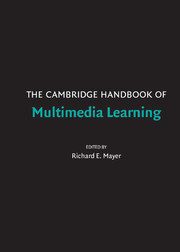Book contents
- Frontmatter
- Contents
- Preface
- Contributors
- 1 Introduction to Multimedia Learning
- PART I THEORETICAL FOUNDATIONS
- PART II BASIC PRINCIPLES OF MULTIMEDIA LEARNING
- PART III ADVANCED PRINCIPLES OF MULTIMEDIA LEARNING
- 14 The Guided Discovery Principle in Multimedia Learning
- 15 The Worked-Out Examples Principle in Multimedia Learning
- 16 The Collaboration Principle in Multimedia Learning
- 17 The Self-Explanation Principle in Multimedia Learning
- 18 The Animation and Interactivity Principles in Multimedia Learning
- 19 Navigational Principles in Multimedia Learning
- 20 The Site Map Principle in Multimedia Learning
- 21 Prior Knowledge Principle in Multimedia Learning
- 22 The Cognitive Aging Principle in Multimedia Learning
- PART IV MULTIMEDIA LEARNING IN CONTENT AREAS
- PART V MULTIMEDIA LEARNING IN ADVANCED COMPUTER-BASED CONTEXTS
- Author Index
- Subject Index
- References
15 - The Worked-Out Examples Principle in Multimedia Learning
Published online by Cambridge University Press: 05 June 2012
- Frontmatter
- Contents
- Preface
- Contributors
- 1 Introduction to Multimedia Learning
- PART I THEORETICAL FOUNDATIONS
- PART II BASIC PRINCIPLES OF MULTIMEDIA LEARNING
- PART III ADVANCED PRINCIPLES OF MULTIMEDIA LEARNING
- 14 The Guided Discovery Principle in Multimedia Learning
- 15 The Worked-Out Examples Principle in Multimedia Learning
- 16 The Collaboration Principle in Multimedia Learning
- 17 The Self-Explanation Principle in Multimedia Learning
- 18 The Animation and Interactivity Principles in Multimedia Learning
- 19 Navigational Principles in Multimedia Learning
- 20 The Site Map Principle in Multimedia Learning
- 21 Prior Knowledge Principle in Multimedia Learning
- 22 The Cognitive Aging Principle in Multimedia Learning
- PART IV MULTIMEDIA LEARNING IN CONTENT AREAS
- PART V MULTIMEDIA LEARNING IN ADVANCED COMPUTER-BASED CONTEXTS
- Author Index
- Subject Index
- References
Summary
Abstract
People gain a deep understanding when they receive worked-out examples in initial cognitive skill acquisition. This is, however, only true when the following guidelines are considered: prompt or train self-explaining examples (guideline of self-explanation elicitation); provide principle-based, minimalist, and example-related instructional explanations as help (help guideline); design examples so that the relations between different representations can be easily detected (easy-mapping guideline); make salient the examples' structural features that are relevant for selecting the correct solution procedure (structure-emphasizing guideline); and facilitate the isolation of meaningful building blocks in worked-out procedures (meaningful building-blocks guideline). Furthermore, series of examples with successively faded worked-out steps should be employed in order to structure the transition from example study to problem solving in later phases of skill acquisition.
Introduction
Learning by doing and learning by solving complex problems are methods of learning that are en vogue and frequently propagated in the literature on learning and instruction in general as well as on multimedia learning. However, often learners have a very restricted understanding of the domain when they try to solve the first problems. In this case, they typically rely on general, domain-unspecific problem-solving heuristics such as means-ends analysis. This actually leads to the correct answer in many cases. However, does such striving for the right answer lead to a profound understanding of the domain? Would it not be better for the students to begin solving problems after they have already gained some significant understanding of the domain?
- Type
- Chapter
- Information
- The Cambridge Handbook of Multimedia Learning , pp. 229 - 246Publisher: Cambridge University PressPrint publication year: 2005
References
- 113
- Cited by

